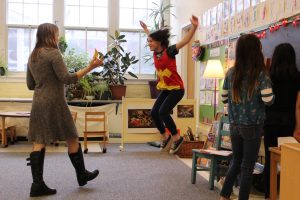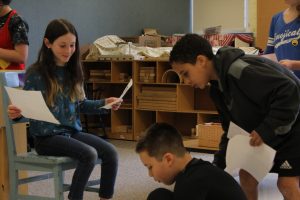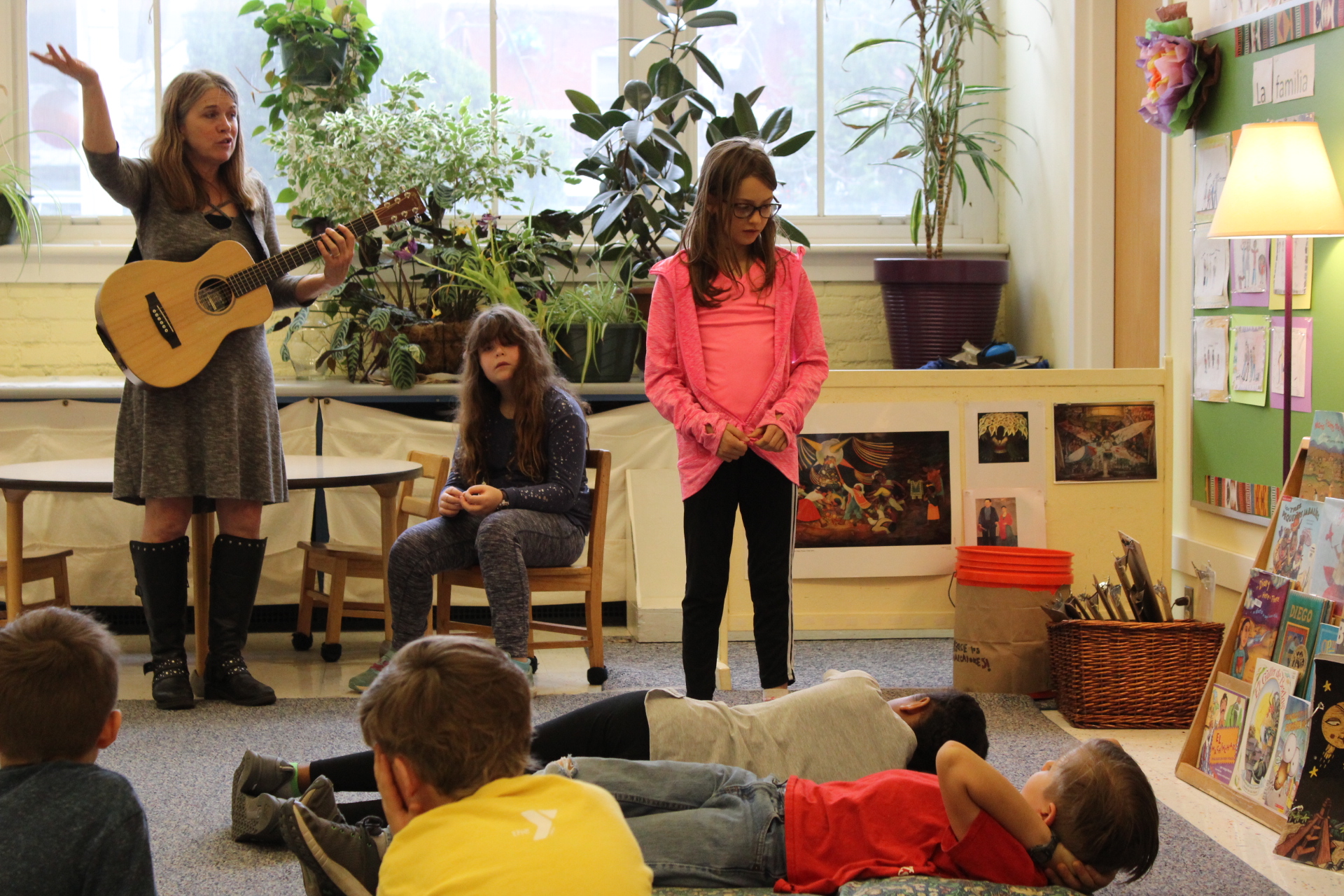At 9:30 in the morning on a gray day in early spring, the strumming of a guitar spills from the Spanish classroom at Campus School. Children are in their places on the rug, not sitting criss-cross-applesauce or taking notes, but acting out their roles in the dramatic reenactment of Doña Luna, a traditional children’s story about the moon goddess of the Maya. One hour later, fourth graders jump up and down as they call to their peers in Spanish, roleplaying shop vendors at an open-air market selling self-designed fashions (vibrant colored pencil drawings of vests, corduroys, and skirts) for bargain prices, making deals with their customers and exchanging pretend money.
At the heart of the excitement is Spanish teacher Lesley Smith– affectionately referred to as Señora Smith by students– who, in her twenty-two years at Campus School, has worked to infuse language learning with creative dramatic play. “We’re all standing on the shoulders of those who came before us,” she says. “My mom was a creative dramatics teacher, and she is an inspiration to me. Many of the theater games that I use in my classroom, I learned as a child.”
Underlying Lesley’s use of song, dance, and theater in the classroom is a belief in what linguist Stephen Krashen called “comprehensible input,” or the idea that second-language acquisition works best in “low anxiety situations, containing messages that students really want to hear,” rather than “extensive use of conscious grammatical rules, and… tedious drill.” Lesley will share her knowledge about these topics at the 2019 American Council on the Teaching of Foreign Languages conference in Washington, DC, where she will present a paper called “Bringing Stories to Life,” grounded in her curricular work at Campus School.
—
Lesley’s k-6 Spanish classes are structured around the belief that natural communication facilitates the language learning process: “I believe so strongly that using multiple modalities for learning language makes it so compelling,” she says. “Literary dramatic play has some element of music or rhythm, like a chant or a song. and I use musical accompaniment or play a recording that provides auditory cues; for example, a drumming sound represents the thunder god, and a particular melody represents the stars. It’s a way to support comprehensible input. Creative dramatics in the world language classroom are a terrific way to create an imaginative and engaging setting for comprehensible input.”

Lesley integrates creative dramatics across grade-levels, introducing language learning with close attention to differentiating instruction according to students’ cognitive development. “The younger children, who have shorter attention spans and are at the very beginning of learning language, do what I call ‘pretends.’ They will have a prop or two, and they take turns doing three lines… let’s say, pretending to go to a store and ask for a piece of fruit and say thank you. One student will be the shopkeeper, another the customer, and they love doing it for each other. It’s very much like the dramatic play that already happens in their classrooms, but I’m giving them some language to use in Spanish… I try to have it sync up with the dramatic play that they’re already doing, so when they’re doing babies or store or vet, I do similar things in Spanish so that it carries over into their classrooms and they can keep practicing. I’m so thrilled when Janice Henderson reports back to me that she’s hearing students use Spanish outside of our time together.”
By the time students reach second and third grade, Lesley introduces literature “as a springboard for creative dramatic play,” with much thought given to the cultural authenticity of narratives:
I start by introducing the characters using illustrations and other visual aids. Then I read the book in Spanish, pausing to confirm comprehension along the way. Next, we look at the story again asking children to remember some of the key language.The process includes up to five or six repetitions of the book, adding different elements to each reading. Students practice key dialogue in a chorus, and as individuals, taking turns to play different parts. They move around, use hand motions, and put on funny voices. Sometimes, I’ll have stations set up in different parts of the room for a story that has, say, a journey (this is the mountain, this is the cave, the village), but other stories like The Little Red Hen happen all in one place. Each play-along has props.
I’ve been working hard to cultivate stories that are appropriate for students’ age level and are primary source material; in other words, stories that are authentic, that come from Spanish-speaking cultures and convey cultural information as well as a really interesting story. I’ve been reading a lot of books!
In fourth grade, students learn to read in Spanish and delve even more deeply into narratives by using scripts in their dramatic play. Lesley creates most of the scripts herself, paying attention to length and controlled, targeted vocabulary: “I’ve created a couple of different plays,” she says, “but I’m working towards finding more culturally authentic narratives that are conveying stories about people from Spanish-speaking countries who live in the United States, or what it’s like– the climate, the food, the products and practices and ideas– in Spanish-speaking parts of the world.”
Classes’ comparative analysis between cultures is guided by Lesley’s textual analysis, which she elaborated upon, saying:
It’s really interesting to compare and contrast narratives like The Three Little Pigs. Everyone jumps in because that’s the frame of reference for our Western Massachusetts culture, but it’s really a Western European story. It’s really cool to put it side by side with a similar story—The Three Little Javelinas, (Los Tres Pequeños Jabalíes) by Susan Lowell—from the southwest of the United States. There are Three Pigs stories from all over the world. In second grade, students use a mexican folktale from Ayutla, Mexico, called Borreguita and the Coyote about a sheep out-smarting a coyote that reminds me of other “outsmarting” stories. Children are invited to compare and contrast similar stories and the cultural settings of the stories. In terms of what strategies we can come up with to strengthen our curriculum to be more tolerant and representational of diverse cultures, it’s a wasted opportunity to not use authentic resources, and it’s disrespectful, too, because the Spanish language is spoken by a huge diaspora.

Nearing the end of their time at Campus School, fifth and sixth graders continue text-based work through dramatic reenactments– skits related to grammatical structures or vocabulary groups that structure a more formal learning of Spanish. The units are geographically rooted, focused around places and varying aspects of culture: schools in New Mexico, family and food in Puerto Rico. Students engage in an extensive unit on the topic of Latinx people living in the United States, and the creative dramatics activities that Lesley incorporates into the unit are more “real life”– focused, she says, on “the idea of preparing someone to be able to answer questions if asked in Spanish.” Fifth and sixth graders enjoy participating in Mad Libs-inspired skits, in which they practice a skit that they learned in class but with missing words that invite students to create their own variations on a theme. Other times, they create comic strips that illustrate one another’s skits. Lesley says that she sees herself facilitating “a combination of scripted and improvisational learning,” both of which are braided in these types of classroom exercises.
—
Lesley’s early fascination with language fuels her work with elementary students, connecting her always to a beginner’s frame of mind: “I’ve always loved languages,” she says. “When I was eight, I decided to teach myself French. We went to the library and got a multi-volume set of ‘Learn to Speak French’ records, and I worked my way through every single one of them. But at the very beginning, I asked my father what my name would be if I were a French girl, and he was such a kidder he told me I would’ve been Mademoiselle. So I went and made all of the kids in my neighborhood call me Mademoiselle! And a little bit later I figured out that Mademoiselle wasn’t a name, it was a title! My parents got me some French lessons, and then came Spanish in school. I was lucky enough to travel with my family, and that really reinforced my Spanish. I just found myself feeling like my brain was percolating when I spoke it. I studied it in college and traveled to Spain and Mexico enough times to really root it in me. My undergraduate degree is in linguistics and literature, and my graduate degree at Umass, is in education, in multicultural education and curriculum development. I loved learning about curriculum; I think that linguistics and curriculum are the same kind of thinking—looking at patterns, creating sequences, both are similar that way.”
Of her career path and tenure at Campus School, Lesley expresses gratitude: “I feel so grateful that I have a job that integrates all the things I love to do. Sometimes I wake up and say: ‘I have the best job in the world!’ Because I get to speak Spanish, use that organizing, analytical part of my brain in setting up a wide curriculum for many children that follows a sequence and reaches national standards, and I get to sing. I’m also a musician– I play in a couple of bands– and that’s a big passion of mine. And I get to hang out with kids! How lucky is that?”
Written by Brittany Collins

Comments are closed, but trackbacks and pingbacks are open.